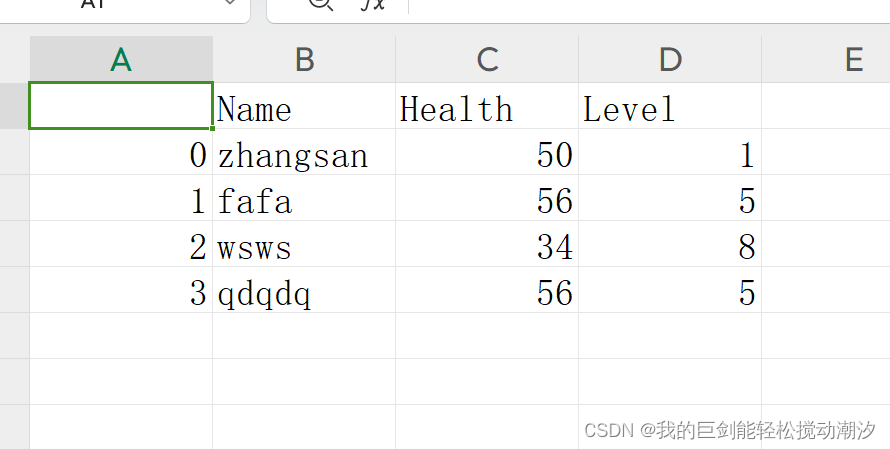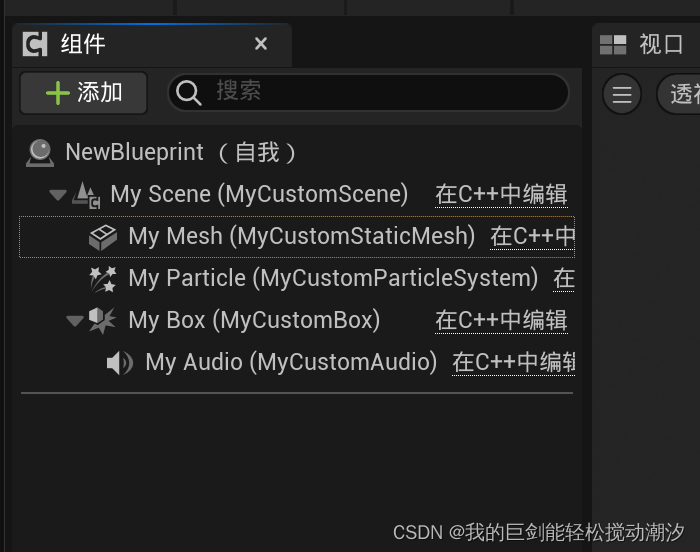目录
导入csv表格数据
创建、实例化、结构体
GameInstance
Actor
camera
绑定滚轮控制摇臂移动
碰撞绑定
角色碰撞设定
按钮
UI显示
单播代理
多播和动态多播
写一个接口
其他
NewObject 和 CreateDefaultSubobject区别
导入csv表格数据
创建一个object的C++类
// Fill out your copyright notice in the Description page of Project Settings.#pragma once#include "CoreMinimal.h"
#include "UObject/NoExportTypes.h"
#include "CharacterMsgObject.generated.h"USTRUCT(BlueprintType)
struct class CharacterMSG:public FTableRowBase {GENERATED_USTRUCT_BODY()UPROPERTY(EditAnywhere,BlueprintReadWrite,Category="CharacterMsg")FString Name;UPROPERTY(EditAnywhere,BlueprintReadWrite,Category="CharacterMsg")float Health;UPROPERTY(EditAnywhere,BlueprintReadWrite,Category="CharacterMsg")int32 Level;
}
UCLASS()
class CPDD1_API UCharacterMsgObject : public UObject
{GENERATED_BODY()};
编译生成
做一个csv表格,对应结构体的元素

拖拽csv到UE5中
导入时选中上述创建的结构体

创建、实例化、结构体
// Fill out your copyright notice in the Description page of Project Settings.#pragma once#include "CoreMinimal.h"
#include "Engine/Classes/Engine/DataTable.h"
#include "UObject/NoExportTypes.h"
#include "CharacterMsgObject.generated.h"USTRUCT(BlueprintType)
struct FCharacterMSG :public FTableRowBase
{GENERATED_USTRUCT_BODY()FCharacterMSG();//略UPROPERTY(EditAnywhere, BlueprintReadWrite, Category = "CharacterMsg")FString Name;UPROPERTY(EditAnywhere, BlueprintReadWrite, Category = "CharacterMsg")float Health;UPROPERTY(EditAnywhere, BlueprintReadWrite, Category = "CharacterMsg")int32 Level;};
UCLASS()
class CPDD1_API UCharacterMsgObject : public UObject
{GENERATED_BODY()
public:FCharacterMSG CMSG;//供实体类调用
};
//创建实例UCharacterMsgObject* MyTestMSGObject; MyTestMSGObject = NewObject<UCharacterMsgObject>(GetWorld(), UCharacterMsgObject::StaticClass());if (MyTestMSGObject) {UE_LOG(LogTemp, Warning, TEXT("MyObject is %s"), *MyTestMSGObject->GetName());UE_LOG(LogTemp, Warning, TEXT("NAME is %s"), *MyTestMSGObject->CMSG.Name);UE_LOG(LogTemp, Warning, TEXT("HEALTH is %f"), MyTestMSGObject->CMSG.Health);UE_LOG(LogTemp, Warning, TEXT("LEVEL is %d"), MyTestMSGObject->CMSG.Level);}GameInstance

UMyGameInstance* MyGameInstance;MyGameInstance = Cast<UMyGameInstance>(GetWorld()->GetFirstPlayerController()->GetGameInstance());应用游戏实例类

Actor
// Fill out your copyright notice in the Description page of Project Settings.#pragma once#include "CoreMinimal.h"
#include "Components/SceneComponent.h"
#include "Components/StaticMeshComponent.h"
#include "Components/BoxComponent.h"
#include "Particles/ParticleSystemComponent.h"
#include "Components/AudioComponent.h"
#include "GameFramework/Actor.h"
#include "MyActor.generated.h"UCLASS()
class CPDD1_API AMyActor : public AActor
{GENERATED_BODY()public: // Sets default values for this actor's propertiesAMyActor();protected:// Called when the game starts or when spawnedvirtual void BeginPlay() override;public: // Called every framevirtual void Tick(float DeltaTime) override;UPROPERTY(VisibleAnywhere,BlueprintReadWrite,Category="MySceneComponent")class USceneComponent* MyScene;UPROPERTY(VisibleAnywhere,BlueprintReadWrite,Category="MySceneComponent")class UStaticMeshComponent* MyMesh;UPROPERTY(VisibleAnywhere,BlueprintReadWrite,Category="MySceneComponent")class UParticleSystemComponent* MyParticle;UPROPERTY(VisibleAnywhere,BlueprintReadWrite,Category="MySceneComponent")class UBoxComponent* MyBox;UPROPERTY(VisibleAnywhere,BlueprintReadWrite,Category="MySceneComponent")class UAudioComponent* MyAudio;};
AMyActor::AMyActor()
{// Set this actor to call Tick() every frame. You can turn this off to improve performance if you don't need it.PrimaryActorTick.bCanEverTick = true;MyScene = CreateDefaultSubobject<USceneComponent>(TEXT("MyCustomScene"));MyMesh = CreateDefaultSubobject<UStaticMeshComponent>(TEXT("MyCustomScene"));MyParticle = CreateDefaultSubobject<UParticleSystemComponent>(TEXT("MyCustomParticleSystem"));MyBox = CreateDefaultSubobject<UBoxComponent>(TEXT("MyCustomBox"));MyAudio = CreateDefaultSubobject<UAudioComponent>(TEXT("MyCustomAudio"));RootComponent = MyScene;MyMesh->SetupAttachment(MyScene);MyParticle->SetupAttachment(MyScene);MyBox->SetupAttachment(MyScene);MyAudio->SetupAttachment(MyBox);
}
静态加载类,要加 “_C”
camera
UPROPERTY(VisibleAnywhere,BlueprintReadOnly,Category="MySceneComponent")USceneComponent* MyRoot;
UPROPERTY(VisibleAnywhere,BlueprintReadOnly,Category="MySceneComponent")USpringArmComponent* MySpringArm;
UPROPERTY(VisibleAnywhere, BlueprintReadOnly, Category = "MySceneComponent")UCameraComponent* MyCamera; // Set this pawn to call Tick() every frame. You can turn this off to improve performance if you don't need it.PrimaryActorTick.bCanEverTick = true;MyRoot = CreateDefaultSubobject<USceneComponent>(TEXT("MyRoot"));MySpringArm = CreateDefaultSubobject<USpringArmComponent>(TEXT("MySpringArm"));MyCamera = CreateDefaultSubobject<UCameraComponent>(TEXT("MyCamera"));RootComponent = MyRoot;MySpringArm->SetupAttachment(MyRoot);MyCamera->SetupAttachment(MySpringArm);MySpringArm->bDoCollisionTest = false;绑定滚轮控制摇臂移动
#include "CoreMinimal.h"
#include "GameFramework/PlayerController.h"
#include "SPlayerController.generated.h"/*** */
UCLASS()
class CPDD1_API ASPlayerController : public APlayerController
{GENERATED_BODY()
public:virtual void SetupInputComponent();void WheelUpFunction();void WheelDownFunction();
};绑定键在UE5输入中设置
因为这里的Pawn和Controller都设置为当前gamemode的角色,所有getPawn会锁到当前操控者的Pawn。
#include "SPlayerController.h"
#include "MyPawn.h"void ASPlayerController::SetupInputComponent()
{Super::SetupInputComponent();InputComponent->BindAction("WheelUp", IE_Pressed, this, &ASPlayerController::WheelUpFunction);InputComponent->BindAction("WheelDown", IE_Pressed, this, &ASPlayerController::WheelDownFunction);
}void ASPlayerController::WheelUpFunction()
{if (GetPawn()) {AMyPawn* pawn1= Cast<AMyPawn>(GetPawn());pawn1->Zoom(1,1);}
}void ASPlayerController::WheelDownFunction()
{if (GetPawn()) {AMyPawn* pawn1 = Cast<AMyPawn>(GetPawn());pawn1->Zoom(-1, 1);}
}void AMyPawn::Zoom(float Direction, float Speed)
{float temp = MySpringArm->TargetArmLength - Direction * Speed * 10;if (temp > 2000.f || temp < 500.f)MySpringArm->TargetArmLength = temp;
}
碰撞绑定
UPROPERTY(VisibleAnywhere,BlueprintReadWrite,Category="MySceneComponent")class UBoxComponent* MyBox; MyBox->OnComponentBeginOverlap.AddDynamic(this, &AMyActor::BeginOverlapFunction);MyBox->OnComponentEndOverlap.AddDynamic(this, &AMyActor::EndOverlapFunction);MyBox->OnComponentHit.AddDynamic(this, &AMyActor::OnComponentHitFunction);绑定函数的参数从何而来?

-转到定义
再转到定义
找到同义的参数,看数字,如果是six,就把该函数后6位复制过来,绑定函数的参数括号内,去掉定义类型和变量名之间的逗号即可。
UFUNCTION()void BeginOverlapFunction(UPrimitiveComponent* OverlappedComponent, AActor* OtherActor, UPrimitiveComponent* OtherComp, int32 OtherBodyIndex, bool bFromSweep, const FHitResult& SweepResult);UFUNCTION()void EndOverlapFunction(UPrimitiveComponent* OverlappedComponent, AActor* OtherActor, UPrimitiveComponent* OtherComp, int32 OtherBodyIndex);UFUNCTION()void OnComponentHitFunction(UPrimitiveComponent* HitComponent, AActor* OtherActor, UPrimitiveComponent* OtherComp, FVector NormalImpulse, const FHitResult& Hit);角色碰撞设定
//碰撞设置MyBox->SetCollisionEnabled(ECollisionEnabled::NoCollision);MyBox->SetCollisionEnabled(ECollisionEnabled::QueryOnly);MyBox->SetCollisionEnabled(ECollisionEnabled::PhysicsOnly);MyBox->SetCollisionEnabled(ECollisionEnabled::QueryAndPhysics);MyBox->SetCollisionEnabled(ECollisionEnabled::ProbeOnly);MyBox->SetCollisionEnabled(ECollisionEnabled::QueryAndProbe);//碰撞对象类型MyBox->SetCollisionObjectType(ECC_WorldDynamic);MyBox->SetCollisionObjectType(ECC_WorldStatic);MyBox->SetCollisionObjectType(ECC_Pawn);MyBox->SetCollisionObjectType(ECC_PhysicsBody);MyBox->SetCollisionObjectType(ECC_Vehicle);MyBox->SetCollisionObjectType(ECC_Destructible);//碰撞响应MyBox->SetCollisionResponseToAllChannels(ECR_Block);MyBox->SetCollisionResponseToAllChannels(ECR_Overlap);MyBox->SetCollisionResponseToAllChannels(ECR_Ignore);MyBox->SetCollisionResponseToChannel(ECC_Pawn, ECR_Overlap);//pawn允许重叠MyBox->SetCollisionResponseToChannel(ECC_WorldStatic,ECR_Block);//世界静态阻挡MyBox->SetCollisionResponseToChannel(ECC_WorldDynamic,ECR_Ignore);//世界动态忽略MyBox->SetBoxExtent(FVector(64, 64, 64));按钮
绑定事件绑定函数时不用加括号
// Fill out your copyright notice in the Description page of Project Settings.#pragma once#include "CoreMinimal.h"
#include "Components/Button.h"
#include "Blueprint/UserWidget.h"
#include "MyUserWidget.generated.h"UCLASS()
class CPDD1_API UMyUserWidget : public UUserWidget
{GENERATED_BODY()
public:UPROPERTY(meta=(BindWidget))//UI控件创建的按钮名称和声明名称相同UButton *ButtonStart;UPROPERTY(meta=(BindWidget))UButton* ButtonQuit;UFUNCTION()void Start();UFUNCTION()void Quit();virtual bool Initialize()override;//重写组件初始化函数UPROPERTY(EditAnywhere,BlueprintReadWrite,Category="MyHealth")float CurrentHealth=100.f;UPROPERTY(EditAnywhere,BlueprintReadWrite,Category="MyHealth")float MaxHealth = 100.f;UFUNCTION()void UpdateHealth();
};
#include "MyUserWidget.h"bool UMyUserWidget::Initialize()
{if(!Super::Initialize())return false;ButtonStart->OnClicked.AddDynamic(this, &UMyUserWidget::Start);ButtonQuit->OnClicked.AddDynamic(this,&UMyUserWidget::Quit);return true;
}void UMyUserWidget::UpdateHealth()
{if (CurrentHealth <= 0) {GEngine->AddOnScreenDebugMessage(-1, 5.0f, FColor::Red, TEXT("Death"));}else {CurrentHealth -= 30;}
}void UMyUserWidget::Start()
{GEngine->AddOnScreenDebugMessage(-1, 5.0f, FColor::Red, TEXT("Start"));UpdateHealth();
}void UMyUserWidget::Quit()
{GEngine->AddOnScreenDebugMessage(-1, 5.0f, FColor::Red, TEXT("Quit"));
}UI显示
在游戏模式的控制器脚本的开始运行函数中,
根据资源路径加载类,并创建该类的实例作为“提升为变量”的接盘。
void ASPlayerController::BeginPlay()
{Super::BeginPlay();UClass* widgetClass = LoadClass<UMyUserWidget>(NULL, TEXT("/Script/UMGEditor.WidgetBlueprint'/Game/HbtScripts/MyUserWidget233.MyUserWidget233_C'"));UMyUserWidget* MyWidget = nullptr;MyWidget = CreateWidget<UMyUserWidget>(GetWorld(), widgetClass);MyWidget->AddToViewport();
}单播代理
// Fill out your copyright notice in the Description page of Project Settings.#pragma once#include "CoreMinimal.h"
#include "GameFramework/Actor.h"
#include "MyDelegateActor.generated.h"DECLARE_DELEGATE(NoParamDelegate);//1.声明代理类型
DECLARE_DELEGATE_OneParam(OneParamDelegate,FString);
DECLARE_DELEGATE_TwoParams(TwoParamDelegate, FString, int32);
DECLARE_DELEGATE_ThreeParams(ThreeParamDelegate, FString, int32, float);
DECLARE_DELEGATE_RetVal(FString, RetvalDelegate);UCLASS()
class CPDD1_API AMyDelegateActor : public AActor
{GENERATED_BODY()public: // Sets default values for this actor's propertiesAMyDelegateActor();protected:// Called when the game starts or when spawnedvirtual void BeginPlay() override;public: // Called every framevirtual void Tick(float DeltaTime) override;//2.声明代理名称NoParamDelegate NoParamDelegate;OneParamDelegate OneParamDelegate;TwoParamDelegate TwoParamDelegate;ThreeParamDelegate ThreeParamDelegate;RetvalDelegate RetvalDelegate;//声明代理函数void NoParamFunction();void OneParamFunction(FString str);void TwoParamFunction(FString str,int32 value);void ThreeParamFunction(FString str,int32 value,float balue1);FString RetvalFunction();};
// Fill out your copyright notice in the Description page of Project Settings.#include "MyDelegateActor.h"// Sets default values
AMyDelegateActor::AMyDelegateActor()
{// Set this actor to call Tick() every frame. You can turn this off to improve performance if you don't need it.PrimaryActorTick.bCanEverTick = true;//3.绑定代理方法NoParamDelegate.BindUObject(this, &AMyDelegateActor::NoParamFunction);OneParamDelegate.BindUObject(this, &AMyDelegateActor::OneParamFunction);TwoParamDelegate.BindUObject(this, &AMyDelegateActor::TwoParamFunction);ThreeParamDelegate.BindUObject(this, &AMyDelegateActor::ThreeParamFunction);RetvalDelegate.BindUObject(this, &AMyDelegateActor::RetvalFunction);}// Called when the game starts or when spawned
void AMyDelegateActor::BeginPlay()
{Super::BeginPlay();//4.调用代理NoParamDelegate.ExecuteIfBound();OneParamDelegate.ExecuteIfBound("OneParamDelegate");TwoParamDelegate.ExecuteIfBound("TwoParamDelegate",648);ThreeParamDelegate.ExecuteIfBound("ThreeParamDelegate",648,3.6f);FString strvalue= RetvalDelegate.Execute();
}// Called every frame
void AMyDelegateActor::Tick(float DeltaTime)
{Super::Tick(DeltaTime);}void AMyDelegateActor::NoParamFunction()
{GEngine->AddOnScreenDebugMessage(-1,5.0f,FColor::Blue,TEXT("NoParamDelegate"));
}void AMyDelegateActor::OneParamFunction(FString str)
{GEngine->AddOnScreenDebugMessage(-1, 5.0f, FColor::Blue, FString::Printf(TEXT("%s"),*str));
}void AMyDelegateActor::TwoParamFunction(FString str, int32 value)
{GEngine->AddOnScreenDebugMessage(-1, 5.0f, FColor::Blue, FString::Printf(TEXT("%s,%d"), *str,value));
}void AMyDelegateActor::ThreeParamFunction(FString str, int32 value, float value1)
{GEngine->AddOnScreenDebugMessage(-1, 5.0f, FColor::Blue, FString::Printf(TEXT("%s,%d,%f"), *str, value, value1));
}FString AMyDelegateActor::RetvalFunction()
{FString str = FString::Printf(TEXT("RetvalFunction"));return str;
}多播和动态多播
声明类型
DECLARE_MULTICAST_DELEGATE_OneParam(OneParamMultiDelegate, FString);
DECLARE_DYNAMIC_MULTICAST_DELEGATE_OneParam(FDynamicMutilDelegate,FString,param);声明名称
//多播代理OneParamMultiDelegate OneParamMultiDelegate;//动态多播UPROPERTY(BlueprintAssignable)FDynamicMutilDelegate FDynamicMutilDelegate;绑定方法
//多播代理绑定OneParamMultiDelegate.AddUObject(this, &AMyDelegateActor::MultiDelegateFunction1);执行(参数根据自己定义的类型)
//执行多播代理OneParamMultiDelegate.Broadcast("OneParamMultiDelegate");//执行动态多播代理FDynamicMutilDelegate.Broadcast("FDynamicMutilDelegate");多播代理能同时调用多个函数,区别是动态多播能暴露给蓝图。
多播在脚本中写好绑定的多播函数。
动态多播在此基础上,能在蓝图上额外绑定事件,不止函数。

写一个接口
用I开头那个
声明要重写函数时,有{}
// Fill out your copyright notice in the Description page of Project Settings.#pragma once#include "CoreMinimal.h"
#include "UObject/Interface.h"
#include "TestInterface.generated.h"// This class does not need to be modified.
UINTERFACE(MinimalAPI)
class UTestInterface : public UInterface
{GENERATED_BODY()
};/*** */
class CPDD1_API ITestInterface
{GENERATED_BODY()// Add interface functions to this class. This is the class that will be inherited to implement this interface.
public:virtual void Attack() {};virtual void CaclulateHealth() {};
};
调用,接屁股+头文件

重写
virtual void Attack() override;virtual void CaclulateHealth() override;然后再cpp编写即可。
其他
在使用打印语句时报错什么断点问题点,尝试在打印语句上加UFUNCTION
GEngine->AddOnScreenDebugMessage(-1, 5.0f, FColor::Red, TEXT("Death"));
变量要编辑,组件要可视,然后均为蓝图读写
NewObject和CreateDefaultSubobject区别
NewObject和CreateDefaultSubobject是 Unreal Engine 中用于创建对象的两种不同方式,它们有以下区别:
对象类型:
NewObject可以用于创建任何类型的对象,包括 UObject、AActor、APawn 等。而CreateDefaultSubobject仅适用于在一个类的构造函数或初始化过程中创建默认的子对象。对象生命周期:使用
NewObject创建的对象是动态分配的,并由开发人员负责管理其生命周期。而使用CreateDefaultSubobject创建的对象是由 Unreal Engine 的对象系统自动管理的,它们的生命周期与宿主对象的生命周期相同。对象属性:
CreateDefaultSubobject创建的对象会自动继承宿主对象的属性设置,例如编辑器中设置的默认值、蓝图可编辑性等。而使用NewObject创建的对象需要手动设置属性。宿主对象关系:
CreateDefaultSubobject创建的子对象与宿主对象之间建立了父子关系,这意味着子对象的生命周期与宿主对象紧密相关,并且在宿主对象销毁时,子对象也会被销毁。而NewObject创建的对象没有默认的宿主对象关系。










 R实现)
)



)



